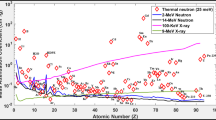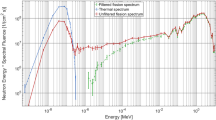Abstract
A new method for non-destructive analysis has been developed using a combined neutron/X-ray imaging system at the Missouri Science & Technology Reactor (MSTR). The interactions of neutrons and X-ray photons with matter produce differing characteristic information, resulting in distinctly different visual images. In order to obtain a more comprehensive picture of the structural and compositional data for a desired object, a prototype imaging system has been designed which utilizes neutron and X-ray imaging simultaneously without obstructing the beam geometry for each imaging mechanism. The current system is optimized for the imaging of small to medium sized objects of 0.5–50 mm. This new imaging capability in place at the MSTR promises great advances in the field of non-destructive testing, especially for nuclear engineering, nuclear medical science, and material science research. In an imaging object, a range of atomic number values and thermal cross-sections may be present. Where multiple materials having similar atomic number and differing thermal cross-section or vice versa may be present, exclusive neutron or X-ray analysis may exhibit shortcomings in distinguishing interfaces. However, fusing the neutron image and X-ray image into a combined image offers the strengths of both and may provide a superior method of analysis. In this paper, a novel combined X-ray and neutron imaging system will be introduced for superior analysis of certain imaging objects. Design details of experimental set-up and examples of preliminary imaging tests from individual modality will be detailed.








Similar content being viewed by others
References
Belgya T, Kis Z, Szentmiklósi L, Kasztovszky Z, Festa G, Andreanelli L, DePascale MP, Pietropaolo A, Kudejova P, Schulze R, Materna T, The Ancient Charm Collaboration (2008) J Radioanal Nucl Chem 278:713. doi:10.1007/s10967-008-1510-0
Belgya T, Kis Z, Szentmiklósi Z, Kasztovszky Z, Kudejova P, Schulze R, Materna T, Festa G, Caroppi PA, The Ancient Charm Collaboration (2008) J Radioanal Nucl Chem 278:751. doi:10.1007/s10967-008-1605-7
Szentmiklósi Z, Belgya T, Revay Z, Kis Z (2010) J Radioanal Nucl Chem 286:501. doi:10.1007/s10967-010-0765-4
Triolo R, Giambona G, Celso FL, Ruffo I, Kardjilov N, Hilger A, Manke I, Paulke A (2010) Conserv Sci Cult Herit 10:143–158
Balasko M, Kuba A, Nagy A, Kiss Z, Rodek L, Ruskó L (2005) Nucl Instrum Methods Phys Res 542:22–27
Vontobel P, Lehmann E, Carlson WD (2005) IEEE Trans Nucl Sci 52:338–341
Neutron vs. X-ray computed tomography: comparative study on the example of a violin (2010) Interaction between wood science and conservation of cultural heritage, Turkey. http://www.woodculther.com/wp-content/uploads/2010/10/COST-IE0601-2010-Izmir_Mannes.pdf. Accessed 7 Dec 2011
Yasuda R, Matsubayashi M, Nakata M, Harada K, Amano H, Sasajima F, Nishi M, Horiguchi Y (2005) IEEE Trans Nucl Sci 52:313–316
Characterization of the Neutron Flux Energy Spectrum at the Missouri University of Science and Technology Research Reactor (MSTR) (2010) Missouri University of Science & Technology, Rolla. http://scholarsmine.mst.edu. Accessed 13 Aug 2010
Poludniowski G, Landry G, DeBlois F, Evans PM, Verhaegen F (2009) Phys Med Biol 54:N433. doi:10.1088/0031-9155/54/19/N01
Tremsin AS, Feller WB, Downing RG (2005) Nucl Instrum Methods Phys Res 539:278–311
X-ray mass attenuation coefficients (2012) National Institute of Standards and Technology, Gaithersburg. http://physics.nist.gov/PhysRefData/XrayMassCoef/tab4.html Accessed 12 Jan 2012
Experimental nuclear reaction data (EXFOR/CSISRS) (2011) Brookhaven National Lab, New York. http://www.nndc.bnl.gov/exfor/exfor00.htm. Accessed 14 Sept 2012
Acknowledgments
The authors are thankful to Bill Bonzer and other MSTR staffs for assistance with experiments. The authors also would like to acknowledge help of Jeffrey Divis, Michael Crabtree and Michael Acton. The efforts here presented are conducted under Missouri S&T Nuclear Engineering program with substantial support have been received from the Department of Energy through General Scientific Infrastructure Support Program and partial support from the Center for Bone and Tissue Repair and Regeneration, Missouri University of Science & Technology.
Author information
Authors and Affiliations
Corresponding author
Rights and permissions
About this article
Cite this article
Sinha, V., Avachat, A.V. & Lee, H.K. Design and development of a neutron/X-ray combined computed tomography system at Missouri S&T. J Radioanal Nucl Chem 296, 799–806 (2013). https://doi.org/10.1007/s10967-012-2062-x
Received:
Published:
Issue Date:
DOI: https://doi.org/10.1007/s10967-012-2062-x




